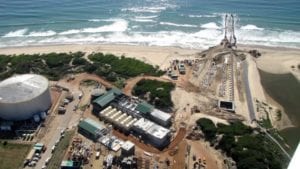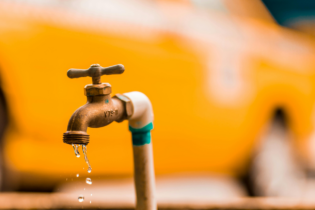Pictured: Mossel Bay desalination plant during construction
Royal HaskoningDHV, leading the future of sustainable water Growing populations, increasing urbanisation and industrial growth is placing severe stress on existing surface and groundwater resources throughout the world. This ongoing growth in water demand and the impacts of climate variability combine to alter our planet and the way we live. This is especially so in arid countries like South Africa where droughts have shown the devastating effects the lack of water can have on communities and economies. This reality requires a passionate, innovative response to provide water security to communities and industry in a long-term sustainable manner with improved levels of assurance, even during disaster situations. The obvious first step is to minimise wastage and make better use of the water we have while heightening awareness and caring for this precious resource. Technological advances and their innovative application make water reuse a viable and completely safe supplement to natural sources. Water reuse solutions must be ‘fit for purpose’ with the specific purpose of providing a sustainable, secure supply of water as part of an overall water resource portfolio. With a legacy of close to one hundred years of water technology experience in Southern Africa, coupled with similar experience worldwide, Royal HaskoningDHV is an acknowledged expert in the field. Dealing with water shortages and the development of water reuse solutions for both potable and industrial water supply were manifest in preventing disaster situations during the recent droughts – the worst in 150 years – that hit the Western and Eastern Cape provinces. These interventions – collectively coined by Royal HaskoningDHV as ‘Life beyond our Rivers’ – have prompted the development of a very specific approach and tailored solution packages that focus on direct and indirect potable reuse; industrial, commercial and agricultural water reuse; and desalination, as well as dealing with situations where de facto reuse take place. Direct potable reuse involves the introduction of reclaimed water from a wastewater treatment works directly into a drinking water treatment system, often involving several advanced treatment steps and technologies to mitigate any risks to the drinking water supply. Indirect potable reuse involves the augmentation of a water (surface or groundwater) source with reclaimed water via an environmental buffer (such as a large dam) before introducing it into the drinking water treatment system. Industrial, commercial and agricultural water reuse can be direct or indirect, depending on the specific requirements of the end users. De facto reuse is a very common occurrence where treated wastewater is being reused, but not officially recognised, for instance where a drinking water supply intake is located downstream of a wastewater treatment plant discharge point. In order to effectively develop and truly benefit from water reuse, an adaptable focus around the specific needs of consumers and our ever- changing environment is required and should include the following: • Strategy for sustainable water – Integrated water resource development and management including the successful introduction of water reuse and desalination into an existing water resource portfolio as part of the planning process.• Future-proof industrial water supply – Introducing water reuse as a sustainable, feasible and potentially cost saving water supply to industrial, commercial and mining users.
• Water reuse extends existing water (and wastewater) infrastructure capacity – Fit-for-purpose water reuse solutions to industrial, mining and water utilities can create capacity on existing infrastructure and unlock other water resource and infrastructure capacity through ‘water trading’ and added benefits to the environment.
• Reducing the water footprint – through water reuse.
• Water reuse = food security – Introduction of water reuse as a safe supply of water for agricultural development.
• Augmentation of potable water supply – through direct or indirect water reuse and desalination. This includes the development of drought intervention solutions and ensuring safe drinking water through integrated water safety plans and wastewater risk abatement plans, which also applies to de facto reuse.
• Life cycle sustainability – Decision-making tools to ensure feasibility of water reuse schemes are essential and should include life cycle costing, risk-based evaluation and management, as well as operation and maintenance solutions.
• Energy efficient solutions – for water reuse and desalination.
• Social acceptance & facilitation – Reuse of water, especially for potable reuse, most often comes with some reluctance to be accepted by communities due to various factors ranging from religious beliefs to ignorance about the subject. Social facilitation and education is critical prior to the development of any water reuse scheme and to its ultimate success. These focus points are key drivers of our overall vision of Enhancing Society Together and the following projects are recent examples of applications of water reuse solutions, successfully implemented or currently under way by Royal HaskoningDHV. George indirect potable water reuse: A 10 Ml/d water reuse plant treating effluent from the Outeniqua WWTW using ultrafiltration technology, providing an indirect potable water supply augmentation via the Garden Route Dam.
Mossel Bay WWTW direct industrial water reuse: As part of a water swop initiative between Mossel Bay Municipality and PetroSA, this reuse plant treats 5 Ml/d effluent from the Mossel Bay WWTW using ultrafiltration and reverse osmosis to supply PetroSA with industrial water in exchange for an equal quantity of their surface water allocation from a nearby dam.
Nelson Mandela Bay direct industrial water reuse: This project, which is in its design phase, will provide 45 Ml/d of direct industrial water reuse via membrane biological reactors at the Fishwater Flats WWTW. Amathole District drought interventions: Several projects at planning and design stage, including a direct potable reuse scheme at Adelaide (1.5 Ml/d) and an indirect potable reuse scheme at Butterworth (5 Ml/d), will provide alternative supplementary water supplies to become more resilient to droughts. Chris Hani District – Strategy for sustainable water: This planning document introduces the strategy, feasibility and specific implementation plans to develop and manage an integrated and optimum combination of water resources as part of the overall portfolio, including the introduction of water reuse. Ultimately, these projects have shown that water reuse is a very feasible, cost-effective and sustainable option that should be considered when reviewing and planning the augmentation of water resources into the future. Whether introducing water reuse as a supplementary supply to potable water, as a main source of industrial water or a combination of the two, it dramatically improves the sustainability and security of water supply with the upside of improved living standards and assurance of developmental and economic growth for the future. Without this intervention, our current water resources would quite likely be here today and gone tomorrow! With our passion for sustainability, a more comfortable scenario an be our water is here today and reused tomorrow.







